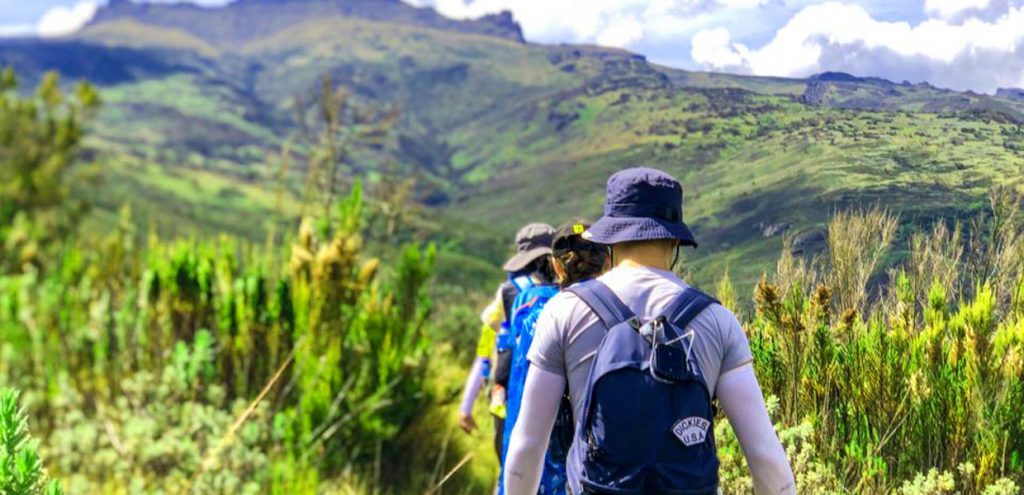Here, we bring you some of Mount Elgon hiking tips and guidelines you should follow. Have your first aid box close to you. When you’re on the trail, the road or out in the fields, a first aid kit will be an essential gear, for immediate treatment incase of cuts and injuries, to prevent long-term complications.
Treating the symptoms of illnesses can sustain you until you reach professional treatment, so it’s very important to have a first-aid kit. If you are in an area that may have them, snake bite kits are also a good idea too. You can have the very nice first aid kit for camping and hiking, but the basics like band-aids, sting ease, aspirin, tape and gauze, could be enough. Benadryl is also a good idea when someone is stung or just for allergies. If you can, it’s usually simpler to just buy a readymade first aid kit.

Wear a cap under your rain jacket hood: This creates an awning to keep rain out of your eyes and from trickling off your face and down your neck. Look for synthetic caps that dry quickly and absorb little to no water, especially if you’re planning to come during the rainy season to climb Mount Elgon. We also guide you on the best time and season to hike Mount Elgon, though climbing Mount Elgon can be done all year round.
More Elgon Hiking Tips and Guidelines:
- Cuff the hem of your hiking pants and shirt sleeves underneath your rain paints and jacket. It’s important to keep your non-waterproof layers from sliding out underneath your shell, as they will quickly start to absorb water. Cuffing ensures they won’t escape their protective layers and provides a buffer zone between what is wet and what is dry.
- Leave your pit zips open as their default setting. In most light-medium rain, the venting benefits of pit zips will outweigh whatever tiny amount of water can sneak in under your arms. Only in heavy rain, in a strong side wind, or when bushwhacking is it worth closing the pit zips.
- Set wrist straps to comfortably tight, the goal is to prevent your rain jacket’s sleeves from riding up. Sleeve riding up results in exposed wrists that will then get the inside of your jacket’s sleeves wet once they’re back in place.
- Tuck your undershirt into your rain pants. Just like cuffing your sleeves or pants, the goal here is to prevent the hem of your shirt from draping below your jacket or becoming exposed to the elements if your jacket should ever ride up. Another benefit is that rain pants often have an elastic waist band that is uncomfortable to wear directly against your skin. This helps prevent chafing.
- Store your rain gear on the outside of your pack. It’s important to keep your rain gear handy so it can be accessed as soon as the rain starts. Comparatively, storing rain gear inside your pack’s main compartment will cause you to get wet while you fish it out, and even worse, allow water to enter the pack.
- In very light rain, wear your hood like a collar. Any time the rain is bad enough to justify a jacket, but too warm or light enough to justify wearing a hood, it’s worth rolling the hood up like a collar. This prevents rain from collecting in the hood like a bucket and from pouring down the back of your neck when the rain gets worse and you decide it’s time to wear the hood.
- If you’re using waterproof gaiters to protect against rain, wear them under your rain pants. This creates a shingle effect that keeps the rain flowing down and out. Wearing gaiters over your rain pants can allow water to trickle down in between the two, eventually landing on your socks or down your boot.
- If possible, when putting a rain jacket on, take another layer off. Rain jackets are warm and sweaty enough with only a base layer, especially during warmer months. If you were already wearing a mid layer, let your rain jacket replace it, not add to it.
- Set the elastic draw cord hem to prevent jacket ride up. Most rain jackets can cinch at the hem, but tightening doesn’t always make it less likely to ride up as you hike. Every jacket interacts differently with every body shape and every backpack. Next time you’re wearing your jacket, see if tightening or loosening at the hem helps keep it in place better.
Besides Mount Elgon hiking tips and guidelines, there are other several important tips for visitors who would wish to explore other parts of the country. Follow the rules and regulations for hiking Rwenzori mountains, or rules and regulations for a gorilla tracking safari.
You would also like to complement your adventure with a visit to Bwindi Impenetrable National Park for an amazing gorilla trekking safari, to encounter the mountain gorillas. This is one of the most exciting Uganda safaris that most visitors have had and turned so memorable
